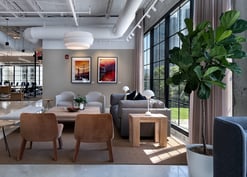With our mobile workforce estimated to reach 1.3 billion globally in 2015, the 9 to 5 workday is poised to join floppy disks and cubicle farms as a relic of our professional past. However, despite the fact that workers don’t need to be in the office to do their job, it remains generally true that they are most productive when they are.
To strike a balance between these two professional realities, employers are undertaking a fundamental shift in their approach to office design: if the workplace is no longer a place people have to be, it should be a place they want to be.
Likewise, as technology continues to make how, where, and when we do our jobs more flexible, employer expectations must follow suit. From Facebook chatting during office hours to answering work emails at 10pm on a Saturday, the distinctions between work life and personal life are becoming increasingly difficult to discern, and as a result, modern offices are reflecting this more integrated work-life approach in a design trend dubbed “domesticating the workplace.”
Here are 3 effective ways to bring the comforts of home into your office design:
1. Focus on Comfort
Making the office feel more like home revolves around creating comfortable, welcoming, human spaces. If you consider that people spend the majority of their waking hours in the office, it’s no surprise that the interior design firm Herman Miller’s research study around comfort in the workplace found that “having an office that is comfortable to work in” is considered the most valuable workstation attribute across all worker types.
This includes more traditionally considered factors like ergonomics, air quality, and temperature, but it also means office designs should account for psychological and emotional comfort. To achieve this, consider bright and naturally-lit space, organic surfaces like wood or bamboo, indoor plants, and creative personal touches like artwork, decorative installations, team photos, or murals.
2. Offer Flexibility
If you ask people to walk you through their workday from home, their responses are sure to vary– some will be stationed at their desk, some will opt to work from their couch, kitchen table, porch or sunroom, and some will not be stationed at all, preferring instead to move around throughout the day.
Despite the variety of workflows, it’s important to note that, for most workers, the home factor isn’t crucial (or even ideal) at all, it’s simply more comfortable and flexible than a more rigid work environment. To adjust employee attitudes towards the workplace, seek to provide the same flexibility mobile workers find at home, while also integrating the social and logistical benefits of an office environment into layout, furniture, and fixtures choices.
The most successful domesticated designs provide a dynamic range of private and communal workstations, including traditional desks, standing desks, couch and lounge areas, kitchen breakfast bars, large communal tables, and outdoor areas. Many companies are also seeing success in adopting a policy of unassigned workstations, which give employees the freedom to move around throughout the week. To further underscore the benefits of being in an office, layouts should include central communal spaces that facilitate face-to-face interactions and spontaneous run-ins.
For examples of creative, flexible, domestically-designed workspaces, check out the San Francisco office furniture company Two’s Pinterest board.
3. Facilitate Downtime
Recent research demonstrates a simple, yet important fact: happy employees are more productive. Because of this, the old school approach of extracting work from employees is giving way to creating office cultures and spaces that inspire and motivate employees to be productive. This doesn’t mean the end of deadlines, it just means less Bill Lumberghs.
Of course, this transition also manifests in interior design. Cubicles take the former approach: isolate people from distractions and they will get more work done. Punch in at 9, punch out at 5, and call it a day. The domesticated workplace takes the latter: give people the freedom to work where they want, create a space for them to take a break when they need, and trust that they’re capable enough to do their job well despite “distractions.”
A game room, outside patio, or even a jam room like at Dropbox’s headquarters, make workers feel valued and trusted, and in turn build a more positive employee-employer relationship. Additionally, creating spaces where workers get to interact and socialize with people outside their department promotes idea sharing and is a staple in successful, creative companies.
All in all, the future of the workplace is looking brighter (and cozier) than ever. If you need to add some personal touches to your space, we'd love to help!

.jpg?width=332&height=177&name=_MG_0840%20copy%20(2).jpg)

.jpg?width=332&height=177&name=dtBv_067_DSC_2139_DaNil%20(2).jpg)



